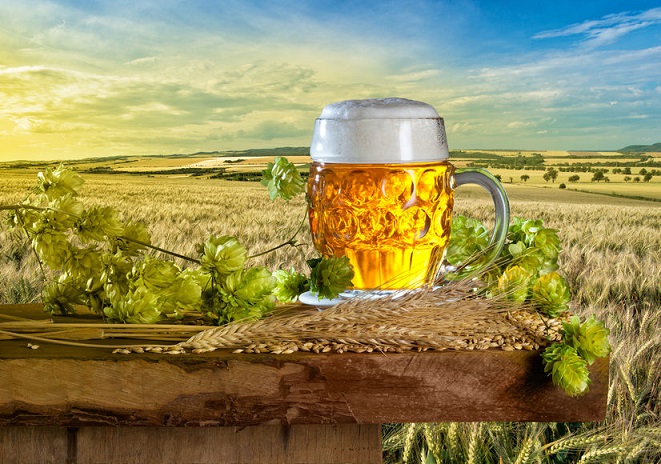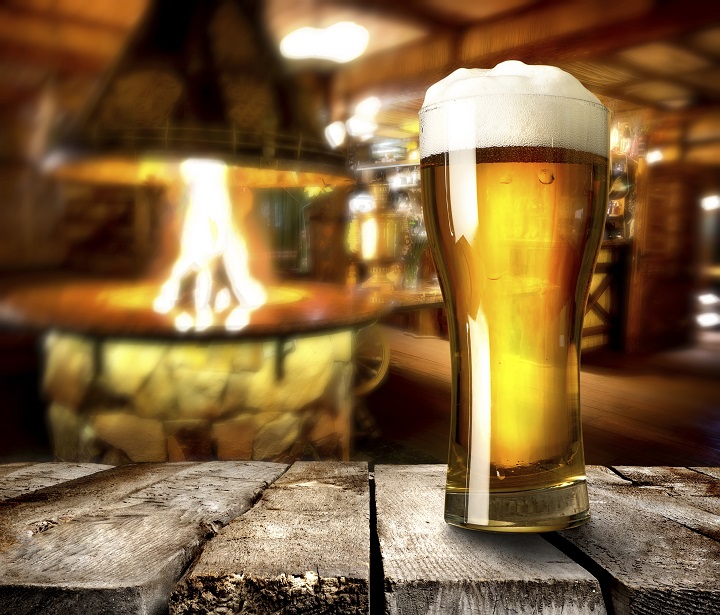 Somewhere out there in the remote corners of the world, it’s possible that the ultimate cure for acne is hiding. It could be a tiny purple berry growing in one rugged, isolated Himalayan valley. It could be a rare neon-coloured seaweed in an Australian coral reef guarded by tiger sharks. It could be a forgotten recipe stashed away, gathering dust in a crazy old pharmacist’s cupboard.
Somewhere out there in the remote corners of the world, it’s possible that the ultimate cure for acne is hiding. It could be a tiny purple berry growing in one rugged, isolated Himalayan valley. It could be a rare neon-coloured seaweed in an Australian coral reef guarded by tiger sharks. It could be a forgotten recipe stashed away, gathering dust in a crazy old pharmacist’s cupboard.
The fact is though, that we’re already discovering natural acne remedies in many weird places…
…and the latest contender is hops, the green herb famous for spicing up beer, but soon perhaps, for eradicating acne worldwide.
The herb that bacteria has nightmares about
The original reason the herb hops was added to beer was its bitterness and aromatic flavour, but one stormy, earth-shattering night during the middle ages, breweries realised that their beers were spoiling much less.
Breweries fear nothing more than bacteria because of its funkification of their finely crafted taste. Examples include firmicutes strains with a rotten egg flavour and lactobacillus with a sour taste. Back in 1100, the antibacterial powers of hops were already known, as German botanist Hildegard von Bingen wrote that hops “fends off decomposition of beverages and increases shelf life“. Nobody knows whether her words spread beyond one dusty old textbook, but it’s said that around 1100, hops pushed aside all other beer preservation herbs formerly used in Germany.
By 1516, German priests solemnly introduced the Reinheitsgebot, mandating that beer may only be made from hops, malt and water. In 1888, a study finally confirmed the antibacterial properties, triggering an avalanche of investigations where hops was found to slay gram positive bacteria, the type mainly found in beer (and luckily, your skin pores).
Hops’ ancient properties were mostly down to organic acid compounds called lupulone, xanthohumol and humulone. It emerged that these compounds can seriously disrupt a bacteria’s cell membrane, causing it to leach plasma.
Xanthohumol and lupulone can actually enter a bacteria’s cell membrane and reduce the PH, short-circuiting its transportation of all-important sugars and amino acids. The bacteria then becomes incapable of manufacturing new cells, and eventually, its precious DNA and RNA. Lupulone and xanthohumol can even act like free radicals, weakening the bacteria cell through oxidation damage.
The end result is cell death and a much tastier beer. The lower the beer’s PH, the more effectively hops suppresses beer bacteria.
But does it work on acne bacteria?
 For 20 years, scientists have tested hops and its compounds against every bacterial strain under the sun. They’ve found benefits for stomach infections, against hospital wing-stalking staphylococcus strains and even synergistic properties with antibiotics.
For 20 years, scientists have tested hops and its compounds against every bacterial strain under the sun. They’ve found benefits for stomach infections, against hospital wing-stalking staphylococcus strains and even synergistic properties with antibiotics.
But until 2019, one name was long missing – propionibacterium acnes, the main acne bacteria. Scientists created a recipe of 50% humulone and 50% lupulone and compared it to the staple antibiotic clindamcyin. While the antibiotic was victorious, the hops compounds reduced both p.acnes bacteria and s. aureas significantly.
Every p.acnes strain tested was reduced, and hops was stronger against the bogeyman p.acnes than s. aureas, with minimal inhibitory concentrations of 3.2 µg/mL vs 9.4 µg/mL. A placebo gel was also tested against p.acnes and the hops formulation was “significantly superior“.
P.acnes was also crippled by a botanical extract consisting of hop extract, white willow, mentha arvensis oil and manuka oil, but with so many ingredients it’s impossible to tell which was responsible, although it does prove the greatness of natural recipes. To test any side effects, the scientists rubbed hop extract on 30 healthy volunteers’ backs, and detected no irritation.
The best part is that elsewhere, hop extract can apparently cut through bacterial biofilms like a butterknife. Biofilms are the bacterial equivalent of nomadic tribes versus cities. It’s when bacteria become incredibly tightly packed and numerous, and then secrete polymers to hold their structures in place. Eradicating biofilms can be incredibly difficult for doctors and p.acnes is also proven to form them.
According to a 2013 study, the hops compound xanthohumol can achieve “almost complete eradication” of an s. aureus biofilm when used in high quantities. A hops extract without the xanthohumol also dismantled the biofilms, proving that hops has numerous antibacterial compounds. The full hop extract shrank the biofilm by 74.8%.
In a more recent 2018 study, the “big three” compounds of humulone, lupulone and xanthohumol all weakened the biofilm. Lupulone was the strongest compound, and in higher concentrations, lupulone and xanthohumol “reduced the number of surviving bacterial cells to zero“.
Does it apply to p.acnes? It’s a fair bet.
An unexpected power, hidden for 1000 years
Inflammation was also examined in 2019, and the hops formulation soothed inflammation even more strongly than the powerful antioxidant luteolin, found in celery, thyme and red grapes.
Hop extract brutally suppressed interleukin-6, a pro-inflammatory chemical directly linked to acne. Similarly, hops extract hoovered up some isolated free radicals nicely. The only flaw was the lack of testing on a living, breathing human being.
This paled compared to another power though – the ability to slow ageing, the obsession of a thousand mad scientists. While hops’ antibacterial powers are backed up by literally billions of happy beer-swillers, two studies suggest that hops can boost collagen and elastin levels. In 2009, xanthohumol, lupulone, and humulone were found to have “moderate to strong anticollagenase inhibitory activities“.
Collagenase, quite simply, is the enzyme that breaks down and recycles old collagen. Too much collagenase and you might as well wrap yourself in bandages and shuffle towards people menacingly. Inhibit collagenase and you could wipe five years of your skin in a blinding flash of light (or maybe two months of patience). Shea butter, for example, can also inhibit collagenase.
Flash forward another year, and a study on xanthohumol specifically also inhibited 1) elastase, which breaks down the skin tightness protein elastin, and 2) matrixmetalloproteinases (MPPs), another group of enzymes connected to collagen degradation.
Then came the final test: the proteins themselves. Elastin and collagen levels both increased dramatically, including collagen types 1, 3, and 9, proving that xanthohumols’s powers weren’t narrow and ultimately useless.
Its benefits were equal to ascorbic acid (vitamin C), the fuel for all your collagen factories. Even the smallest concentrations of xanthohumol inhibited elastase and MPP9 whereas MPP2 and MPP1 required higher doses.
Finding a collagen-booster like shea butter really is the jackpot of topical treatments. Antibacterial properties are more understandable, because plants have to suppress infectious diseases themselves. Antioxidants are common, because countless fruits contain them. But collagen boosting powers pop up randomly with no explanation. Only vitamin C rich-plants make sense, because vitamin C is a fundamental building block. The only flaws were that whole hops wasn’t tested, and that some collagen-controlling enzymes required higher doses.
Was hops used for skincare in ancient times?
 Compared with honey and aloe vera, beloved by the Egyptians, reports of women going crazy for hops beauty remedies are completely missing from the history books.
Compared with honey and aloe vera, beloved by the Egyptians, reports of women going crazy for hops beauty remedies are completely missing from the history books.
Back when she mentioned shelf life in 1158, Hildegard Van Bingen said that hops has no medicinal usage for humans and only “increases melancholy in men”. By the 1200s, hops was everywhere. King Erik VI of Denmark tried to ban hopped beer from Germany in 1281, while in 1230, a Belgian farmer got so drunk on hopped beer that the townsfolk tied him to a wagon wheel.
Sweden introduced the death penalty for stealing hops, and pillars in cathedrals even had hops sculptures embedded in them. However, almost all the old textbooks related to brewing.
When the first medicinal properties did appear, they were for sleeping. King George III of England (1738-1820) devised a comfortable bed with hops-infused pillows to calm his overactive mind at night. King Wenceslas IV incorporated hops into the coat of arms in 1406, supposedly in recognition of the sleep-promoting effects of bathing in cold brewery sludge.
A number of random powers have popped up too, including for treating ear infections in an anonymous 1485 manuscript. Famed doctor Paracelsus (1493–1541) treated indigestion with hops, while Lonicerus (1528–1586) insisted that hops could clear the blood, spleen and liver. Over in Arabia, the scientist Ibn-Al Baitar (1188–1248) recommended hops for digestion and Mesue the Younger (died 1015) for blood purification.
The key is that amidst these endless reports, skincare is rarely mentioned.
The only widespread cosmetic usage was curing hair loss, by pouring glasses of beer over your head. Around 1900, a freshly brewed cup of hops-infused tea could supposedly restore a completely bald head.
Did a medieval brewer ever donate leftover hop herbs to a local wife, who then mixed them into a homemade beauty ointment? It almost certainly happened, but hops were never popular for skincare. Their absence doesn’t proven anything, but it’s strange considering that hops was experimented with for so many other ailments.
Perhaps brewers monopolised the supply and prevented experimentation, or maybe it was a glitch in the matrix of history. Maybe their skincare powers were detected, but vanished into the mists of time. Honey and aloe vera are mindlessly simple to rub on your face, whereas hops is a green, fleshy plant. Or maybe, maybe hops doesn’t have any benefits for acne after all…
Side effects – could they scupper everything?
It’s also possible that hops’ acne benefits might be exiled anyway, because hops contains some natural compounds with known dermatitis (skin irritation) causing properties.
There’s geraniol, beta-myrcene, limonene, and the notorious linalool, blamed for lavender oil’s irritation. The quantities are low and could easily be counteracted by other hops compounds, and the recent 2019 study observed no irritation on the patients’ backs. However, your face tends to be much more sensitive.
In one case study, a woman worked for 30 years on a hops farm, where the plants were pulverised in a mill creating airborne particles. One fateful day, her hands suddenly broke out in dermatitis, and her face and back swelled up. Her symptoms thankfully disappeared, only to come roaring back a mere 30 minutes after returning to work.
Could applying hops regularly create a sensitivity one day? Another report came from 73 farm workers, where hops caused the highest percentage of skin problems. However, picking hops is a completely different game to applying them, because the plants have tiny hairs which brush against farmers’ hands and release a powdery yellow compound called lupulin.
The Cosmetics Safety Review board also experimented on living breathing humans, comparing 0.06% to 0.12% concentration hops to the dreaded toothpaste ingredient sodium lauryl sulfate (SLS). They observed no short term irritation after applying hops for 24 hours straight, and analysing their skin after both 30 minutes and 24 hours.
Contradicting the woman’s case study, there was also no sensitisation potential, which they measured by discontinuing hops for two weeks, applying harsh chemicals and comparing the irritation levels to originally. They ultimately declared hops “safe as used when formulated to be non-sensitizing”, which sounds promising but also cautious.
The signature irritant in hops is beta-myrcene, also found in cannabis and wild thyme leaves, which are 40% beta-myrcene by weight. However, myrcene oxidises in air incredibly easily, and all evidence points to only oxidised myrcene being dangerous. Even then, this study tested 1511 patients and only one reacted to oxidised beta-myrcene. Even then, beta-myrcene is only one small component of hops, and even then, I would advising diluting hops first.
If there’s one worrying chemical, it’s got to be linalool, but this article explains in detail why its dangers are overblown. In short, 97% of linalool dermatitis cases come from oxidised versions, like bottles of lavender oil left in intense sunlight.
Hops isn’t 100% out of the danger zone, particularly considering its short history as a topical treatment, but it doesn’t touch the radioactive skin-shredding bombshell of lemon juice.
Conclusion
If this article was written in 2018, the antibacterial evidence would be overwhelmingly promising, but the jury would still be out, like a dam waiting patiently to burst spectacularly.
P.acnes is gram positive, but there are occasional gram positive strains like lactobacillus brevis which are hop-resistant. Their higher levels of a gene called horA allow them to rapidly eject the lupulone and xanthohumol which infiltrate their membrane. Breweries hate these strains. Therefore, p.acnes would also be in doubt, but now, all the jigsaw pieces are falling into place.
Hops looks like one of the best antibacterial acne treatments of all time. It may lack history, but the evidence is right in front of our eyes. The collagen is the cherry on top. Side effects cannot be ruled out, particularly because of our lack of experience, but its main worrying compounds look like phantom irritants.
The future could be bright for hops, or it could be cast down and forgotten. Only time will tell, but here, we will be keeping an eye on it.
Thanks for reading!